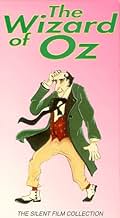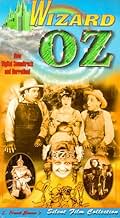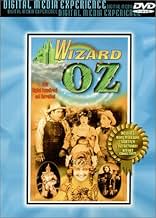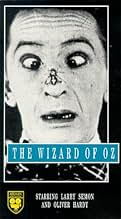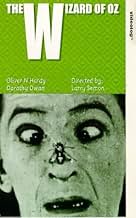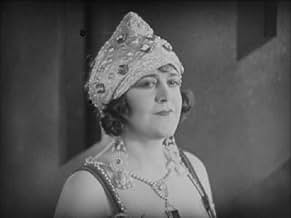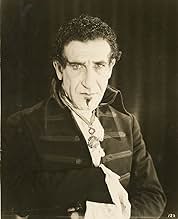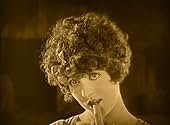ÉVALUATION IMDb
4,9/10
1,9 k
MA NOTE
Dorothy, l'héritière du trône d'Oz, doit le reprendre à l'abject Premier Ministre Kruel avec l'aide de trois ouvriers agricoles.Dorothy, l'héritière du trône d'Oz, doit le reprendre à l'abject Premier Ministre Kruel avec l'aide de trois ouvriers agricoles.Dorothy, l'héritière du trône d'Oz, doit le reprendre à l'abject Premier Ministre Kruel avec l'aide de trois ouvriers agricoles.
- Prix
- 1 victoire au total
Oliver Hardy
- Woodsman
- (as Oliver N. Hardy)
- …
Curtis 'Snowball' McHenry
- Snowball
- (as G. Howe Black)
- …
Rosalind Byrne
- Herald Trumpeter
- (uncredited)
Chester Conklin
- Undetermined Role
- (unconfirmed)
- (uncredited)
Wanda Hawley
- Undetermined Role
- (unconfirmed)
- (uncredited)
Jean Johnston
- Little Girl in open & close
- (uncredited)
Avis en vedette
18-year-old Dorothy (Dorothy Dwan) lives on a Kansas farm, little knowing that she's actually the rightful Queen of the magical land of Oz, which is currently ruled by Prime Minister Kruel (Josef Swickard). After Kruel sends his minion Ambassador Wikked (Otto Lederer) to Kansas to try and steal the document that proves Dorothy is the queen, Dorothy and her friends are transported to Oz, where they meet the Wizard (Charles Murray) and the benevolent Prince Kynd (Bryant Washburn). Dorothy's friends are transformed into the Scarecrow (Larry Semon), the Tin Woodsman (Oliver Hardy), and the Cowardly Lion (Spencer Bell).
This was adapted, produced and directed by silent screen comedy star Larry Semon, a household name at the time, but almost entirely forgotten today. It's nearly half of the running time before Dorothy and her gang get to Oz, with much of the first half of the movie taken up by substandard comedy bits on the Kansas farm. It was strange seeing Hardy as the Tin Woodsman, and sad to see the Cowardly Lion, who spends most of the film as a stereotypical caricature named Snowball.
Semon was too extravagant with his budgets, and soon after declared bankruptcy. 2 years later he was playing supporting roles, like in von Sternberg's 1927 Underworld, before dying in 1928 at age 39 of lung disease.
This was adapted, produced and directed by silent screen comedy star Larry Semon, a household name at the time, but almost entirely forgotten today. It's nearly half of the running time before Dorothy and her gang get to Oz, with much of the first half of the movie taken up by substandard comedy bits on the Kansas farm. It was strange seeing Hardy as the Tin Woodsman, and sad to see the Cowardly Lion, who spends most of the film as a stereotypical caricature named Snowball.
Semon was too extravagant with his budgets, and soon after declared bankruptcy. 2 years later he was playing supporting roles, like in von Sternberg's 1927 Underworld, before dying in 1928 at age 39 of lung disease.
This movie was reportedly the one that sunk Larry Semon's career. Instead of the usual short films he was known for, Semon decided to do something "important" and made this (for the time) long film adaptation of THE WIZARD OF OZ,....or at least that's what the title indicates it should be. The story, it seems, bears little similarity to either the 1939 movie or the books. In fact, apart from a few names here and there, it is pretty much unrecognizable as the story about Dorothy and Oz. Instead, it was just an excuse to string along a lot of familiar and not especially funny gags--like I have seen in several other Larry Semon films, the big stunt is his swinging from tower to tower. A neat stunt the first time you see it, but not when it's old material and has nothing to do with the plot.
Overall, I consider this movie a wasted effort. I know that Semon COULD be funny--like he was in his short films. But here, it's just a confusing and dreary mess. Likewise, having Oliver Hardy in the film SHOULD have been an asset, but he was pretty much wasted as well. While not exactly a classic, the 1910 short silent version was much better and stuck closer to the original story and the 1939 version is a classic. This one is better off staying forgotten or seen by the morbidly curious as the project that may have ultimately destroyed Semon's career.
PS--In addition to being a terrible movie, there is a Black man named "Snowflake" that likes to eat watermelon! Ugghh!!!
Overall, I consider this movie a wasted effort. I know that Semon COULD be funny--like he was in his short films. But here, it's just a confusing and dreary mess. Likewise, having Oliver Hardy in the film SHOULD have been an asset, but he was pretty much wasted as well. While not exactly a classic, the 1910 short silent version was much better and stuck closer to the original story and the 1939 version is a classic. This one is better off staying forgotten or seen by the morbidly curious as the project that may have ultimately destroyed Semon's career.
PS--In addition to being a terrible movie, there is a Black man named "Snowflake" that likes to eat watermelon! Ugghh!!!
After its 1902 tryout in Chicago, the stage play with songs by Paul Tietjens and Baum opened on Broadway in January 1903, running 293 performances before hitting the road, and returning to Broadway for four or five months in 1904. It then toured until 1911, when Baum permitted a host of amateur companies all over America to stage the play. In many areas, it became an annual event.
As Mordaunt Hall noted in his rave review in The New York Times, this version is not based on Baum's 1900 novel but on his 1902 stage musical. Many of the strange changes and eliminations in both the story and the characters were made by Baum himself. In fact, aside from the obvious enlargement of Larry Semon's role with the addition of a goodly number of comic routines, this movie is a pretty faithful transcription of the play.
True, some of the best jokes (the business with packing cases, for example), are worked to exhaustion. The main problem I find, however, is not that the stage play and movie have been converted into slapstick, but that the movie without the songs is often rather dull, despite the best efforts of Oliver Hardy and Charlie Murray.
As Mordaunt Hall noted in his rave review in The New York Times, this version is not based on Baum's 1900 novel but on his 1902 stage musical. Many of the strange changes and eliminations in both the story and the characters were made by Baum himself. In fact, aside from the obvious enlargement of Larry Semon's role with the addition of a goodly number of comic routines, this movie is a pretty faithful transcription of the play.
True, some of the best jokes (the business with packing cases, for example), are worked to exhaustion. The main problem I find, however, is not that the stage play and movie have been converted into slapstick, but that the movie without the songs is often rather dull, despite the best efforts of Oliver Hardy and Charlie Murray.
I approached this film with great interest. Being a fan of Oz in general and silent film in particular, this seemed like a sure fit. Well, it's hard to put all prejudices aside, having (like most people) been bombarded with various adaptations of L. Frank Baum's book that one naturally has preconceptions.
Now, I won't bother to comment on the liberties taken in this film, the 1939 film bears, in all truth, barely a passing resemblance to Baum's dark and bizarre novel. The problem is, the changes made for this film just don't work. It's really just a standard silent slapstick film, but not a very funny one.
It's hard to sit through 90 minutes of lame jokes and vulgar stereotypes. But, as a historical curiosity, the film merits a once-over. I cannot, however, endorse the release pictured on the IMDb page, with it's "Digital Soundtrack" and "Narration." The music is inappropriate and the narration is silly...I mean, I CAN read for myself thank you! It was like sitting in the theatre with some rude patron talking to the screen! I expect this was added for children watching the films, but I really don't think many young children today would sit through this, sadly.
See it at least once, but don't expect too much from it.
Now, I won't bother to comment on the liberties taken in this film, the 1939 film bears, in all truth, barely a passing resemblance to Baum's dark and bizarre novel. The problem is, the changes made for this film just don't work. It's really just a standard silent slapstick film, but not a very funny one.
It's hard to sit through 90 minutes of lame jokes and vulgar stereotypes. But, as a historical curiosity, the film merits a once-over. I cannot, however, endorse the release pictured on the IMDb page, with it's "Digital Soundtrack" and "Narration." The music is inappropriate and the narration is silly...I mean, I CAN read for myself thank you! It was like sitting in the theatre with some rude patron talking to the screen! I expect this was added for children watching the films, but I really don't think many young children today would sit through this, sadly.
See it at least once, but don't expect too much from it.
Even in it's day, I think that this movie would have been looked on as rather average. It just isn't a patch on the classic 1939 version. The scarecrow, the tin man and the cowardly lion are not characters, but rather disguises that three of the characters "put on". And there is no witch at all. [Margaret Hamilton, we miss you.] Although the plot is good, the way it's done would confuse younger children, and it somehow just doesn't hold up. It is interesting to see, only for its historic aspect.
Le saviez-vous
- AnecdotesMany theatres that booked the film never received it because its production caused Chadwick Pictures to go bankrupt, and distribution ceased long before it was intended to.
- GaffesThe plane that brings Kruel's emissaries from Oz to Kansas is a triplane in midair but a biplane when it lands.
- Citations
Prime Minister Kruel: Do your stuff, Wizzy!
- Autres versions2005 DVD release on Warner Brothers (as a bonus feature with the 1939 version) alternates between sepia tone-colored images and blue-tinted images.
- ConnexionsFeatured in Wiz on Down the Road (1978)
Meilleurs choix
Connectez-vous pour évaluer et surveiller les recommandations personnalisées
- How long is The Wizard of Oz?Propulsé par Alexa
- What is this film's connection to MGM's 1939 version with Judy Garland?
Détails
- Durée1 heure 35 minutes
- Mixage
- Rapport de forme
- 1.33 : 1
Contribuer à cette page
Suggérer une modification ou ajouter du contenu manquant

Lacune principale
By what name was The Wizard of Oz (1925) officially released in India in English?
Répondre

